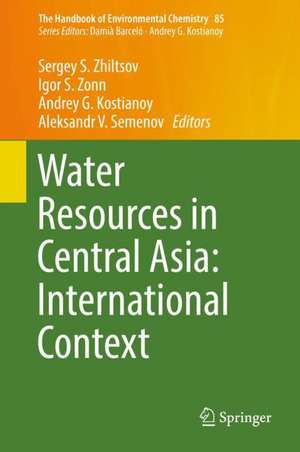Water Resources in Central Asia: International Context: The Handbook of Environmental Chemistry, cartea 85
Editat de Sergey S. Zhiltsov, Igor S. Zonn, Andrey G. Kostianoy, Aleksandr V. Semenoven Limba Engleză Hardback – 5 feb 2019
Together with the companion volumes on Water Bodies and Climate Change in Central Asia and Water Resources Management in Central Asia, it offers a valuable source of information for a broad readership, from students and scientists interested in the environmental sciences, to policymakers and practitioners working in the fields of water resources policy and management, international relations, and environmental issues.
Din seria The Handbook of Environmental Chemistry
- 18%
 Preț: 1819.46 lei
Preț: 1819.46 lei - 18%
 Preț: 1827.32 lei
Preț: 1827.32 lei - 18%
 Preț: 2102.76 lei
Preț: 2102.76 lei - 18%
 Preț: 2089.35 lei
Preț: 2089.35 lei - 18%
 Preț: 2481.57 lei
Preț: 2481.57 lei - 18%
 Preț: 1223.43 lei
Preț: 1223.43 lei - 5%
 Preț: 1419.56 lei
Preț: 1419.56 lei - 15%
 Preț: 639.41 lei
Preț: 639.41 lei -
 Preț: 392.97 lei
Preț: 392.97 lei - 5%
 Preț: 366.56 lei
Preț: 366.56 lei - 18%
 Preț: 1826.69 lei
Preț: 1826.69 lei - 15%
 Preț: 640.71 lei
Preț: 640.71 lei - 18%
 Preț: 728.91 lei
Preț: 728.91 lei - 5%
 Preț: 1424.89 lei
Preț: 1424.89 lei - 18%
 Preț: 1225.94 lei
Preț: 1225.94 lei -
 Preț: 386.00 lei
Preț: 386.00 lei - 18%
 Preț: 732.70 lei
Preț: 732.70 lei - 15%
 Preț: 641.53 lei
Preț: 641.53 lei - 5%
 Preț: 1416.81 lei
Preț: 1416.81 lei - 15%
 Preț: 644.82 lei
Preț: 644.82 lei - 5%
 Preț: 1421.76 lei
Preț: 1421.76 lei -
 Preț: 386.39 lei
Preț: 386.39 lei -
 Preț: 389.49 lei
Preț: 389.49 lei - 5%
 Preț: 719.02 lei
Preț: 719.02 lei - 5%
 Preț: 714.63 lei
Preț: 714.63 lei - 18%
 Preț: 1215.22 lei
Preț: 1215.22 lei -
 Preț: 392.97 lei
Preț: 392.97 lei - 18%
 Preț: 1832.08 lei
Preț: 1832.08 lei - 15%
 Preț: 639.73 lei
Preț: 639.73 lei - 5%
 Preț: 1925.56 lei
Preț: 1925.56 lei -
 Preț: 381.98 lei
Preț: 381.98 lei - 5%
 Preț: 363.97 lei
Preț: 363.97 lei -
 Preț: 386.00 lei
Preț: 386.00 lei - 5%
 Preț: 1423.39 lei
Preț: 1423.39 lei - 15%
 Preț: 643.16 lei
Preț: 643.16 lei -
 Preț: 383.12 lei
Preț: 383.12 lei - 15%
 Preț: 642.51 lei
Preț: 642.51 lei - 5%
 Preț: 716.09 lei
Preț: 716.09 lei - 5%
 Preț: 1407.87 lei
Preț: 1407.87 lei - 18%
 Preț: 1231.01 lei
Preț: 1231.01 lei
Preț: 2475.28 lei
Preț vechi: 3018.63 lei
-18% Nou
Puncte Express: 3713
Preț estimativ în valută:
473.65€ • 495.77$ • 394.22£
473.65€ • 495.77$ • 394.22£
Carte tipărită la comandă
Livrare economică 31 martie-14 aprilie
Preluare comenzi: 021 569.72.76
Specificații
ISBN-13: 9783030112042
ISBN-10: 3030112047
Pagini: 350
Ilustrații: XII, 281 p. 70 illus., 35 illus. in color.
Dimensiuni: 155 x 235 mm
Greutate: 0.59 kg
Ediția:1st ed. 2018
Editura: Springer International Publishing
Colecția Springer
Seria The Handbook of Environmental Chemistry
Locul publicării:Cham, Switzerland
ISBN-10: 3030112047
Pagini: 350
Ilustrații: XII, 281 p. 70 illus., 35 illus. in color.
Dimensiuni: 155 x 235 mm
Greutate: 0.59 kg
Ediția:1st ed. 2018
Editura: Springer International Publishing
Colecția Springer
Seria The Handbook of Environmental Chemistry
Locul publicării:Cham, Switzerland
Cuprins
Introduction.- Water resources in Central Asia: Historical overview.- Legal framework of interstate cooperation on water resources of Central Asia.- Institutional cooperation on water resources in Central Asia.- Transboundary rivers in Central Asia: Cooperation and conflicts among countries.- Application of the UNECE Environmental Conventions in Central Asia.- Water-Energy-Food-Environmental Nexus in Central Asia: From Transition to Transformation.- U.S. Policy in Central Asia: Water-Energy Nexus Priorities.- German water resources policy in Central Asia.- Water Transboundary Policy of Kazakhstan and China.- Water resource policy of Kazakhstan.- Contemporary Water Policy of Kyrgyzstan.- Impact of Water and Energy Problems on the Economic Development of Uzbekistan.- Soft Power of Tajikistan on the Water Agenda: Cross-Scale Dynamics.- Turkmenistan water resghources policy in Central Asia.- Afghanistan water resources policy in Central Asia.- Conclusions.
Textul de pe ultima copertă
This book outlines the current status of water resources management in Central Asia countries, and provides a review of the history, policies and transboundary cooperation regarding water resources in the region. Particular attention is given to the water-energy-food-environmental nexus, and to the application of the UNECE Environmental Conventions in Central Asia. Readers will also learn about the US and German environmental policies applied in Central Asia, and will discover specific case studies on water resources policies in Kazakhstan, China, Kyrgyzstan, Uzbekistan, Tajikistan, Turkmenistan, and Afghanistan.
Together with the companion volumes on Water Bodies and Climate Change in Central Asia and Water Resources Management in Central Asia, it offers a valuable source of information for a broad readership, from students and scientists interested in the environmental sciences, to policymakers and practitioners working in the fields of water resources policy and management, international relations, and environmental issues.
Together with the companion volumes on Water Bodies and Climate Change in Central Asia and Water Resources Management in Central Asia, it offers a valuable source of information for a broad readership, from students and scientists interested in the environmental sciences, to policymakers and practitioners working in the fields of water resources policy and management, international relations, and environmental issues.
Caracteristici
Explores the water-energy-food-environmental nexus in Central Asia Reviews water resources management, policies and transboundary cooperation Offers a valuable guide for environmental managers, scientists and policymakers alike
